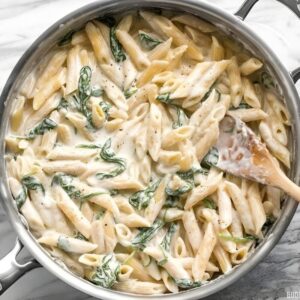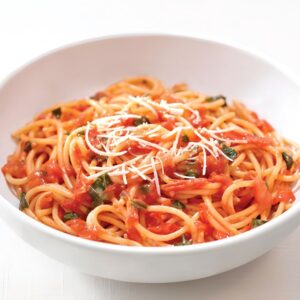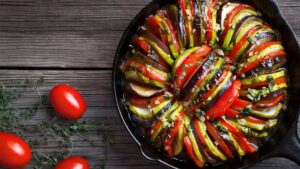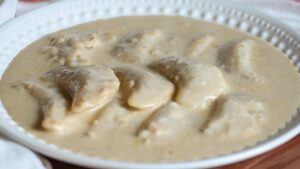Spaghetti with Garlic and Olive Oil
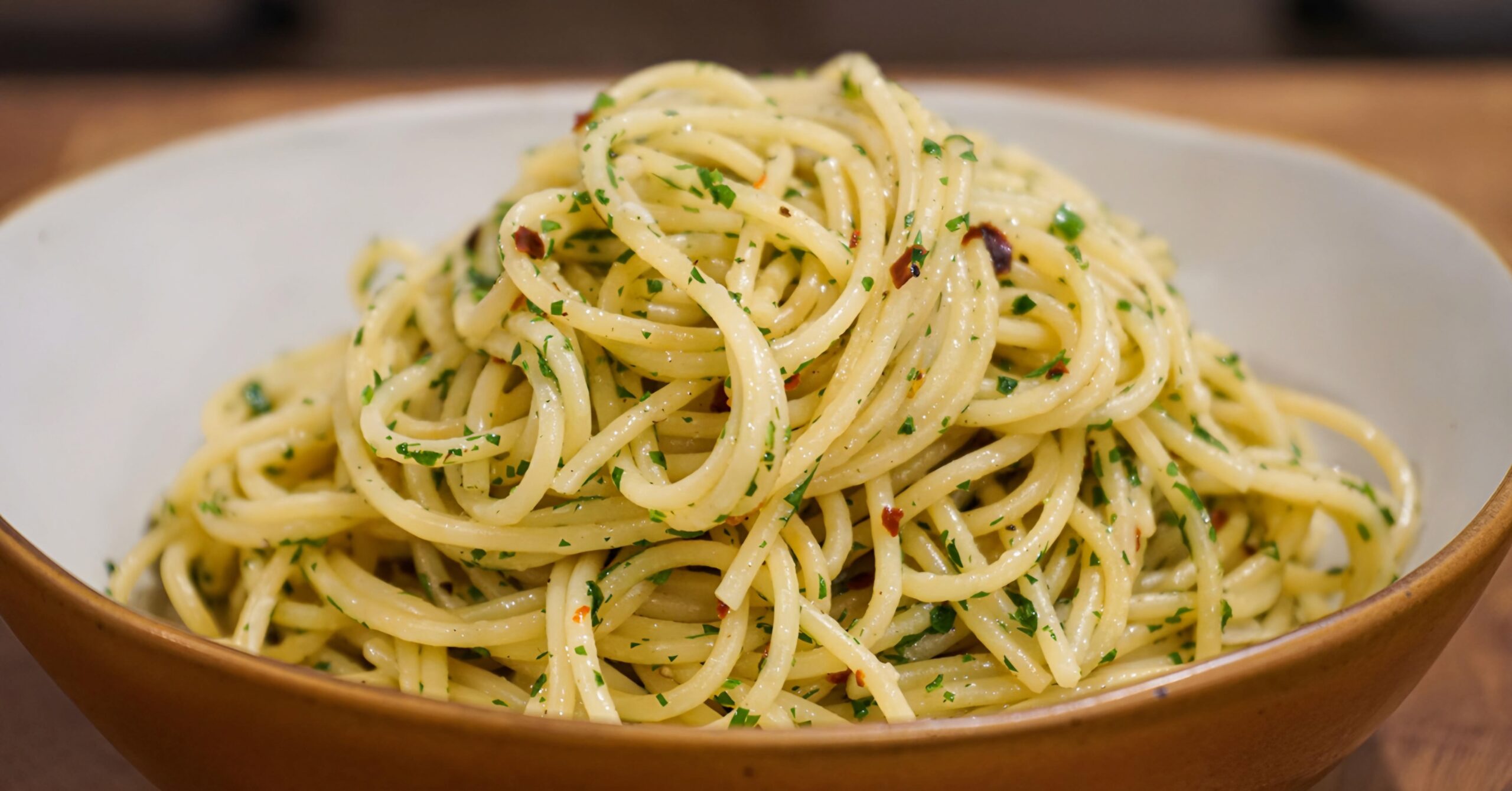
Spaghetti with Garlic and Olive Oil Recipe: A Flavorful Italian Delight
Spaghetti with garlic and olive oil is a beloved Italian dish that has stood the test of time. With its simple yet robust flavors, it has become a go-to recipe for many pasta lovers. Today, we bring you a step-by-step guide to preparing this classic Italian delight in the comfort of your own kitchen.
Spaghetti with Garlic and Olive Oil Recipe ingredients:
- 1 lb (450g) spaghetti
- 4 cloves of garlic, minced
- 1/2 cup (120ml) extra-virgin olive oil
- Red pepper flakes (optional)
- Salt and pepper to taste
- Fresh parsley, chopped (for garnish)
Spaghetti with Garlic and Olive Oil Recipe Making process:
- Cook the spaghetti: Fill a large pot with water and bring it to a boil. Add a generous amount of salt to the boiling water. Then, carefully add the spaghetti and cook it until al dente, following the package instructions. Remember to stir occasionally to prevent sticking.
- Prepare the garlic-infused olive oil: While the spaghetti is cooking, heat the olive oil in a large skillet over medium heat. Add the minced garlic and sauté it until it turns golden brown, stirring frequently. Be cautious not to burn the garlic, as it can turn bitter.
- Add a touch of spice: If you enjoy a bit of heat, you can sprinkle some red pepper flakes into the skillet with the garlic-infused olive oil. This step is optional and can be adjusted according to your preference for spiciness.
- Drain and transfer the spaghetti: Once the spaghetti is cooked to perfection, drain it well using a colander. Be sure to reserve a small amount of the pasta water, as it can be used to adjust the consistency of the sauce later on. Transfer the drained spaghetti directly into the skillet with the garlic-infused olive oil.
- Toss and coat the spaghetti: Using tongs or a pasta fork, toss the spaghetti in the skillet, ensuring that every strand is coated with the flavorful oil. If the pasta seems a bit dry, add a splash of the reserved pasta water to moisten it and create a silky sauce.
- Season to taste: Add salt and pepper to the spaghetti, adjusting the seasoning according to your preference. Remember that the saltiness of the dish can vary depending on the saltiness of the pasta water and the saltiness of the olive oil used.
- Serve and garnish: Once the spaghetti is well-coated and seasoned, transfer it to individual serving plates. Garnish with a sprinkle of freshly chopped parsley to add a touch of freshness and color to the dish.
- Enjoy the flavors of Italy: Spaghetti with garlic and olive oil is best enjoyed fresh and hot. Serve it as a standalone dish or pair it with a side of crusty bread and a crisp green salad for a complete meal. Savor each bite as the flavors of garlic and olive oil come together in perfect harmony.
- With this simple recipe, you can bring a taste of Italy into your home. Whether you’re a seasoned chef or a beginner in the kitchen, spaghetti with garlic and olive oil is a dish that anyone can master. So gather your ingredients, put on some Italian music, and get ready to indulge in a delightful culinary experience.
- Remember, the beauty of this recipe lies in its simplicity. So embrace the flavors of garlic and olive oil, and let the essence of Italian cuisine transport you to the streets of Rome or the shores of Sicily. Buon appetito!
Here are some frequently asked questions (FAQs) related to the spaghetti with garlic and olive oil recipe:
Q1: Can I use any type of pasta for this recipe?
A: While spaghetti is the traditional choice for this dish, you can certainly experiment with other types of pasta, such as linguine or fettuccine. The key is to use a long and thin pasta that can hold the sauce well.
Q2: Can I use minced garlic from a jar instead of fresh garlic cloves?
A: While fresh garlic cloves provide the best flavor, you can use minced garlic from a jar as a convenient alternative. However, keep in mind that the flavor might be slightly different, so adjust the quantity to your taste.
Q3: How do I prevent the garlic from burning?
A: It’s essential to keep an eye on the garlic while sautéing it. Stir it frequently and ensure the heat is not too high to prevent it from burning. Burnt garlic can turn bitter and ruin the overall taste of the dish.
Q4: Is it necessary to add red pepper flakes?
A: No, adding red pepper flakes is optional. It adds a hint of spiciness to the dish, but if you prefer a milder flavor, feel free to omit them. Adjust the level of spice according to your personal preference.
Q5: Can I add other ingredients to enhance the flavor?
A: While spaghetti with garlic and olive oil is traditionally a simple dish, you can customize it to your liking. Some common additions include sautéed mushrooms, cherry tomatoes, or even grated cheese. However, keep in mind that these additions may alter the classic taste of the dish.
Q6: Can I make this dish in advance and reheat it?
A: This dish is best enjoyed fresh and hot. While you can reheat leftovers, the texture of the pasta may change, and the flavors may not be as vibrant. It is recommended to prepare it just before serving for the best taste and texture.
Q7: Can I substitute regular olive oil with extra-virgin olive oil?
A: Extra-virgin olive oil is preferred for this recipe as it adds a rich and robust flavor. However, if you don’t have it on hand, you can use regular olive oil as a substitute. Just keep in mind that the flavor may be slightly different.
Q8: How can I make this dish vegetarian or vegan?
A: This recipe is naturally vegetarian. To make it vegan, ensure that the pasta you use is egg-free. Also, check the label of your olive oil to ensure it is vegan-friendly. Avoid adding any animal-based ingredients or cheese as toppings.
Q9: Can I adjust the amount of garlic and olive oil?
A: Yes, the quantities mentioned in the recipe are a guideline. Feel free to adjust the amount of garlic and olive oil to suit your taste preferences. Just remember that these ingredients are the key flavor components of the dish.
Q10: Can I make this dish gluten-free?
A: Yes, you can use gluten-free spaghetti or any other gluten-free pasta to make this dish suitable for those with gluten sensitivities or preferences. Ensure that all other ingredients you use are also gluten-free.


